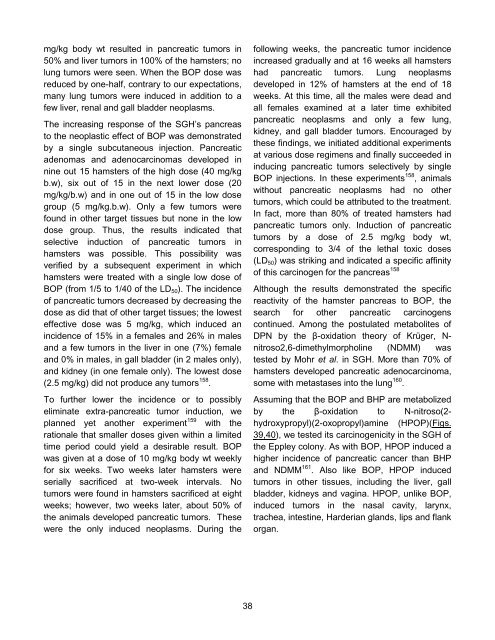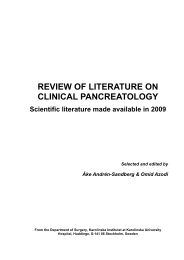Download PDF - The Pancreapedia
Download PDF - The Pancreapedia
Download PDF - The Pancreapedia
You also want an ePaper? Increase the reach of your titles
YUMPU automatically turns print PDFs into web optimized ePapers that Google loves.
mg/kg body wt resulted in pancreatic tumors in<br />
50% and liver tumors in 100% of the hamsters; no<br />
lung tumors were seen. When the BOP dose was<br />
reduced by one-half, contrary to our expectations,<br />
many lung tumors were induced in addition to a<br />
few liver, renal and gall bladder neoplasms.<br />
<strong>The</strong> increasing response of the SGH’s pancreas<br />
to the neoplastic effect of BOP was demonstrated<br />
by a single subcutaneous injection. Pancreatic<br />
adenomas and adenocarcinomas developed in<br />
nine out 15 hamsters of the high dose (40 mg/kg<br />
b.w), six out of 15 in the next lower dose (20<br />
mg/kg/b.w) and in one out of 15 in the low dose<br />
group (5 mg/kg.b.w). Only a few tumors were<br />
found in other target tissues but none in the low<br />
dose group. Thus, the results indicated that<br />
selective induction of pancreatic tumors in<br />
hamsters was possible. This possibility was<br />
verified by a subsequent experiment in which<br />
hamsters were treated with a single low dose of<br />
BOP (from 1/5 to 1/40 of the LD50). <strong>The</strong> incidence<br />
of pancreatic tumors decreased by decreasing the<br />
dose as did that of other target tissues; the lowest<br />
effective dose was 5 mg/kg, which induced an<br />
incidence of 15% in a females and 26% in males<br />
and a few tumors in the liver in one (7%) female<br />
and 0% in males, in gall bladder (in 2 males only),<br />
and kidney (in one female only). <strong>The</strong> lowest dose<br />
(2.5 mg/kg) did not produce any tumors 158 .<br />
To further lower the incidence or to possibly<br />
eliminate extra-pancreatic tumor induction, we<br />
planned yet another experiment 159 with the<br />
rationale that smaller doses given within a limited<br />
time period could yield a desirable result. BOP<br />
was given at a dose of 10 mg/kg body wt weekly<br />
for six weeks. Two weeks later hamsters were<br />
serially sacrificed at two-week intervals. No<br />
tumors were found in hamsters sacrificed at eight<br />
weeks; however, two weeks later, about 50% of<br />
the animals developed pancreatic tumors. <strong>The</strong>se<br />
were the only induced neoplasms. During the<br />
38<br />
following weeks, the pancreatic tumor incidence<br />
increased gradually and at 16 weeks all hamsters<br />
had pancreatic tumors. Lung neoplasms<br />
developed in 12% of hamsters at the end of 18<br />
weeks. At this time, all the males were dead and<br />
all females examined at a later time exhibited<br />
pancreatic neoplasms and only a few lung,<br />
kidney, and gall bladder tumors. Encouraged by<br />
these findings, we initiated additional experiments<br />
at various dose regimens and finally succeeded in<br />
inducing pancreatic tumors selectively by single<br />
BOP injections. In these experiments 158 , animals<br />
without pancreatic neoplasms had no other<br />
tumors, which could be attributed to the treatment.<br />
In fact, more than 80% of treated hamsters had<br />
pancreatic tumors only. Induction of pancreatic<br />
tumors by a dose of 2.5 mg/kg body wt,<br />
corresponding to 3/4 of the lethal toxic doses<br />
(LD50) was striking and indicated a specific affinity<br />
of this carcinogen for the pancreas 158<br />
Although the results demonstrated the specific<br />
reactivity of the hamster pancreas to BOP, the<br />
search for other pancreatic carcinogens<br />
continued. Among the postulated metabolites of<br />
DPN by the β-oxidation theory of Krüger, Nnitroso2,6-dimethylmorpholine<br />
(NDMM) was<br />
tested by Mohr et al. in SGH. More than 70% of<br />
hamsters developed pancreatic adenocarcinoma,<br />
some with metastases into the lung 160 .<br />
Assuming that the BOP and BHP are metabolized<br />
by the β-oxidation to N-nitroso(2hydroxypropyl)(2-oxopropyl)amine<br />
(HPOP)(Figs.<br />
39,40), we tested its carcinogenicity in the SGH of<br />
the Eppley colony. As with BOP, HPOP induced a<br />
higher incidence of pancreatic cancer than BHP<br />
and NDMM 161 . Also like BOP, HPOP induced<br />
tumors in other tissues, including the liver, gall<br />
bladder, kidneys and vagina. HPOP, unlike BOP,<br />
induced tumors in the nasal cavity, larynx,<br />
trachea, intestine, Harderian glands, lips and flank<br />
organ.












